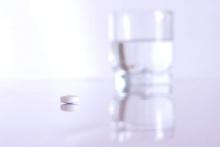NEW YORK – In children with insomnia, melatonin is the appropriate first-line drug therapy, but pharmacologic treatments come after behavioral interventions, according to an evidence-based summary presented at a psychopharmacology update held by the American Academy of Child and Adolescent Psychiatry.
“Medication should rarely be our first choice. We should always be trying to combine it with behavioral therapies, because they work just as well and last longer,” reported Dr. Jess P. Shatkin, a professor in the department of child and adolescent psychiatry, New York University.
The number of randomized trials for sleep medications in children is limited, and there is no pharmacotherapy approved by the Food and Drug Administration for this indication, Dr. Shatkin said. Clinicians often extrapolate from adult studies, but Dr. Shatkin said these data are not necessarily transferable. He noted, for example, that a study of zolpidem in children, which is approved for adults, was negative.
The antihistamine diphenhydramine also has been studied in children, and results were mixed. In one of two double-blind, placebo-controlled pediatric studies, parents reported improvement in getting children to sleep. In the other, conducted in children aged 6 months to 15 months, no significant advantage was found for this agent over placebo.
“[Diphenhydramine] Benadryl may make your kids sleep, it may make your patients sleep, it may make you sleep, which is fine, but the data do not convince us that [diphenhydramine] Benadryl is a great treatment for sleep in children,” Dr. Shatkin reported.
Rather, the best data are with melatonin, an endogenous hormone produced on a circadian rhythm correlating with the end-of-day phenomenon known as dim-light melatonin onset (DLMO). In one study conducted in otherwise healthy children aged 6 to 12 years with chronic sleep-onset insomnia, the administration of exogenous melatonin decreased sleep-onset latency by 35 minutes as measured with actigraphy, according to Dr. Shatkin. Similar benefit has been observed in studies conducted in children with attention-deficit/hyperactivity disorder (ADHD) and autism spectrum disorders (ASD).
“Melatonin is efficacious in typically developing children and those with neurodevelopmental disorders. It imposes minimal effects on sleep architecture, it is associated with a low risk of side effects, the cost is low, and it is widely available,” Dr. Shatkin said. However, he advised against using this drug in children younger than 6 months old.
“The timing of the dosing is critical and should be based on DLMO,” Dr. Shatkin said. Specifically, he recommended a starting dose of 0.2 to 0.5 mg administered 2-3 hours before sleep time. The dose can be increased as needed by 0.2-0.5 mg per week to a maximum of 3.0 mg. Dr. Shatkin reported that there is “little evidence” to support extended-release formulations, but he did warn that over-the-counter preparations may vary in quality.
As an alternative, clonidine was listed as a second choice for treating insomnia in children. Although this therapy is not supported by controlled data, several open-label studies and chart reviews suggest benefit, and this therapy is less likely than diphenhydramine to produce next-day drowsiness.
Yet, he reiterated that the best evidence-based treatment of sleep problems in children is cognitive-behavioral therapy. He called the techniques – such as regular bedtimes, avoidance of stimuli, and creating a relaxing bedtime ritual – as easy to learn and teach to parents. Obvious problems in the sleep routine, such as irregular bedtimes, typically can be identified with a sleep history. There are numerous strategies to wean children from requiring the presence of a parent to fall asleep, such as “graduated extinction,” which involves incrementally distancing the parent from the child’s bedside.
Empathetic to the frequency of sleep disturbances in children, Dr. Shatkin cited data suggesting that 50% of preschool children, 30% of school-age children, and 40% of adolescents report sleep problems. A survey of child psychiatrists found that most acknowledged prescribing a sleep medication within the past month for pediatric insomnia, but Dr. Shatkin emphasized that behavioral therapies often may produce a longer-lasting result.
For treating pediatric sleep disturbances, “our educational and behavioral efforts really should trump our medications,” Dr. Shatkin said. “We should be using any medication sparingly.”
Dr. Shatkin reported financial relationships with Assurex Health, Edgemont Pharmaceuticals, Eli Lilly, Forest Laboratories, and Lundbeck.


